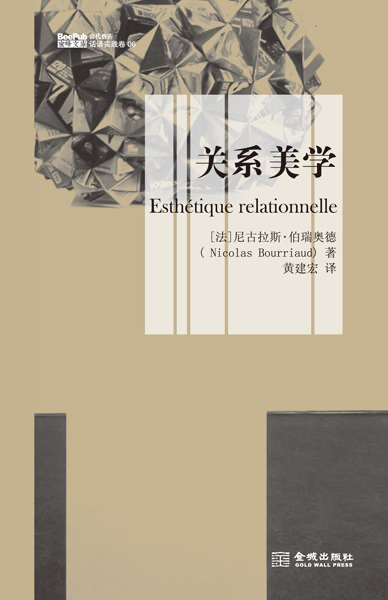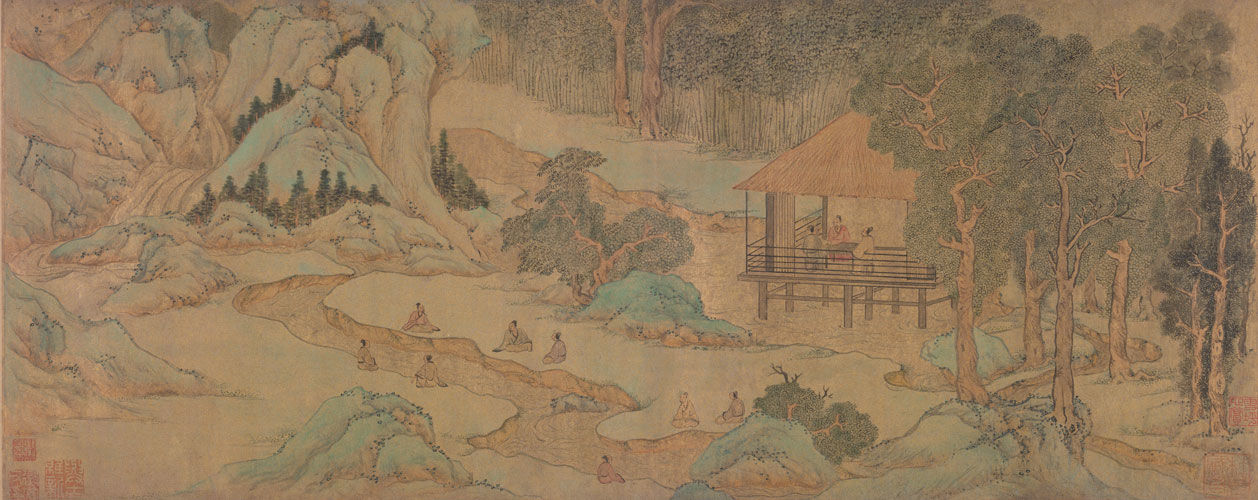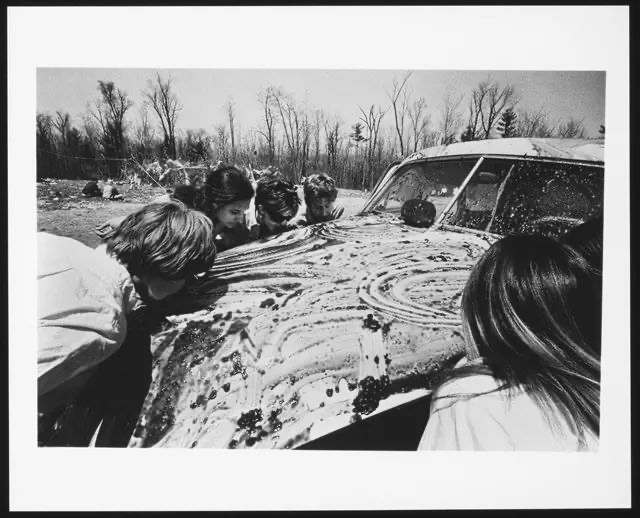
藝術干货 艺术評論 生活美學 作為一個藝術的旁觀者和观察者,活在當下觀自在。 based in Shenzhen & London
From relational aesthetics to "bitified" art, what exactly is "accidental" art?
Relational aesthetics , also known as relational art , is a pattern or trend in art practice to explain some of the new directions in art in the 1990s. This theory was first proposed in 1995 by the French planner and critic Nicolas Bourriaud. In 1998, he wrote "Relational Aesthetics", which explained the artistic thought and artistic exploration in the 1990s, and proposed the difference between the art of the 1990s and the art of the previous era.

Berioud believes that relational aesthetics is not an independent private space, but a model of artistic practice that develops theoretically or practically from the overall human relationship and social context (“Relational Aesthetics: A set of artistic practices which take as their theoretical and practical point of departure the whole of human relations and their social context, rather than an independent and private space.”). At this time, the artist should be regarded as a "catalyst" for presenting relational aesthetics. In a certain sense, the artist can be regarded as a transmission tool serving the audience, and it is necessary to anticipate the other party to judge the content of his creation by using it in a certain sense. information transfer” and exchange of information between audiences. And in this context, any work of art can be considered a relational object. It gives the audience a new way of viewing and experience, and more importantly, they use their own power in art.
Relational aesthetics emphasize intersubjectivity, contingency, sharing, and universal connection together , rather than liberation and communication . Marx believed that art is a kind of social fabric , and the production of art is the communication relationship between human beings realized through production and exchange. The artistic media relations in the works of art are: between people, between people and things, and even between things.
person to person
As early as in ancient China, there was a kind of relational aesthetics that originated from the communication activities between people, which was called Qushui Liuyuan . It was first recorded in Wang Xizhi's "Orchid Pavilion Collection Preface": "There are high mountains and lofty mountains, lush forests and bamboos, and clear and turbulent currents, reflecting the belt around, leading to think that the river is flowing and winding water, and it is ranked second." This is an ancient and interesting way of entertainment, which originated from the ancient Shangsi Festival. The ancient literati liked to find an elegant and secluded place, and sat by the curved river in order. At the beginning of the game, sitting on the upper reaches of the river, one person took a cup full of wine from the upstream to the downstream, and the period was like a wine cup. Stop in front of a certain person, and this person needs to compose a poem in a slightly drunk mood after drinking.


people and things
As early as the 1960s, there were many relational artists who created similar works, such as Newman's work from the United States: "Walking Around the Square in an Exaggerated Way"

In his black and white film, "Walking Around the Square in an Exaggerated Way" (also known as "Walking"), created in his studio. He places one foot in front of the other and walks back and forth, his hips visibly wiggling around the edge of the square tape affixed to the studio's concrete floor. The only sound in the background is the quick click of the film, which draws more attention to the camera itself. Newman didn't ask anyone else to help shoot or track him, just to keep the camera from capturing and tracking his movements. He fixed the camera in one place. Occasionally walks on the edge part outside the shot and disappears off the screen.
While the film may seem simple on the surface, Newman broke with the traditions of film, television and art production itself at the time. With little narrative or fantasy, the work is like a pantomime. More importantly, it takes the viewer into a space they wouldn't normally see - the private realm of the artist's studio. Walking is based on a statement made by Newman shortly after completing his MFA in 1966, in which he emphasized: "If I'm an artist and I'm in a studio, then what I do in the studio Everything has to be art. At this point, art is more of an activity than a product.”
Art itself cannot be tied or bound by anything. As Susan Sontag said in her "Against Interpretation": Interpretation is the revenge of intelligence on art. Interpreting a work of art is like "defining" the work of art. Before being defined, a work brings different feelings to different viewers, but if it is imposed on a specific "meaning", this makes the work itself easy to control and can be copied.
thing and thing
Korean artist - Nam June Paik , his work "TV Buddha" , which is a video sculpture, was created by Nam June Paik in 1974. This work presents a live broadcast, with a camera pointed at the front of a Buddha statue watching its own image on a TV screen. Through the projection of the camera, the Buddha stared at his image on the television screen , asking the question of himself in a constant contest of stares. The subject of the act of "seeing" is not a person, but a Buddha statue. After all, the state of mind of Buddha watching TV is difficult to understand. He may be confused, joyful, or he may be sympathetic and scrutinized. Buddhism believes that everyone has Buddha-nature and has the possibility of becoming a Buddha.

When artists use objects as a creative medium, Hegel puts forward his remarks about art: the generation of past artworks as "Things" blurs the identity of artists and their works, and more works are later sublimated into The artistic creation with "original" also emphasizes that the "Thing" created by the artist is "Work" . Relational aesthetics sees art as a human means by which people get out of exchange. The venue for displaying art works is actually a community of art sharing and exchange, forming a specific exchange field. After the 1990s, the rise of contemporary art and the development of critical theory became Event, which also gave birth to artistic behavior . Therefore, artists create their own original works of art by the "creator", and the connection between the two adds another layer of relationship with the audience, and the social activities that connect the three are called accidental art , which is an art form that blurs the boundaries between art and people's daily life.
Proposed by American conceptual artist Allan Kaprow. In his work "Ladies Licking the Jam on the Car" , in the process of the ladies licking the jam on the car, the traces of the tongue licking were left on the hood of the car, which also left the trace of this behavior. This work transcends the boundaries of a physical work of art, focusing on movement, process, and the engagement of performer and audience.

It can be seen that the "material" of art creation has changed from people, objects, and events to a kind of dissemination of the "process" of the formation of works of art as the carrier of art. Innovation in the sense of "material" or "communication" will lead to important changes in art form and aesthetics. From the perspective of traditional art, the "material sense" of the art medium is gradually dispersing. In the past, most of the art media were “archives” that can be touched and felt, but in contemporary art, a more virtual “de-materialized” art work has appeared, such as digital art. Most of this art form relies on (visual photography), digital tools have changed from movie screens, TV screens to mobile terminal computer screens and mobile phones, so the "shell" of art works has gradually transformed into a retreat trend , which makes the audience pay more attention to the virtual content itself, while the desire to experience the content of the previous works of art is much lower, and the audience tends to a de-object and de-substantial aesthetic. At the same time, the relationship between the artwork and the viewer forms a virtual "face-to-face" relationship. Therefore, in more cases, this virtual and intangible content is more like an "archive" material stored in a metal chip.
Heidegger also paid attention to the meaning of materials used in artworks. He believed that artworks are a kind of "special identity" existing in materials. He said: "All artworks should have the characteristics of "objects", and architectural art In stone, woodcut in wood". This is a kind of reproduction, but it is more like a "reproduction" of the material's original form.
However, digital media has limited people's imagination, and the content of communication in the eyes of the public has become single and convergent. This "communication method" similar to circuit communication can be measured in seconds in terms of transmission speed, bringing viewers to into a cocoon of information explosion. A "bitified" world consisting of a series of invisible, intangible, colorless, weightless, and volumeless 0s and 1s. "Bitization" is a chaotic world, which completely and real-time bitizes the physical world, and also includes the functions of VR, MR, and AR devices. With the development of artificial intelligence, the daily "art" on the screen will have a very high intervention force on the viewer, and the highly mediated content no longer has the attributes of art, but has more ethical implications. This kind of "everyday + accidental" "art" will change people's cultural attitudes towards ethics and the ethical world, as well as affect the "ethical sense" of individual existence and the virtual world in which the individual resides. The influence of mediated art is huge. Human beings are more likely to feel an invisible "anxiety" and "surprise" between the current media existence and culture, high-density information coverage, and large-scale content replication. , resulting in a "mandatory aesthetic", with a high degree of intervention, and "words" are constantly emphasized, as if more real than real. Ultimately, it is difficult for humans to escape under the "simulated world" of the "mandatory" aesthetic constructed by digital art.
Here, the word [relationship] becomes very subtle. People and digital tools (mobile phones and other digital products) have changed from a "real (touchable) relationship to a separation and uncertainty, resulting in A state in which the human "subject" is not present can easily lead people to adopt a sadistic attitude towards emotion and its expression. On the contrary, oral or written communication carries a very serious ethical responsibility. Therefore, the "keyboard" breeds The emergence of people who are extremely lacking in morality and ethics. The process of human beings from infants to socialization, this explosive "everyday" information makes everyone look up and down, and they are in "class" every day. If the "textbook" is excellent, then..., wine has obtained a positive aesthetic consensus; on the contrary, if the "textbook" is poor, then..., it has also accepted the influence of this so-called "ugly", a cultural of decline.
As Danner said in Philosophy of Art: "Every age re-examines unsolved cases; . The court gets the same comment, and when the judges scattered over the centuries have made the same verdict, then the verdict is probably reliable.” And the judgment mentioned here is a kind of spontaneous thinking and critical consciousness of people. Of course, from the essence of art, the fundamental form of art is independent and free expression, which is a kind of transcendence of human beings over human beings. In this process, the creator will gradually become "balanced and unified" in the face of the final work, and this process is like the creator resolving the contradiction with his own work. Hone the mind and will of the artists.
What kind of active thinking does our generation and the next generation need? It is hoped that they can make an effective and the same "judgment" on the "art" of this era, instead of forming a "collective unconscious" and "rubbing" a mechanical reproduction art without thinking.
· E
Author: Han Yu
WeChat ID: Han Yu's Art Research Institute

Like my work?
Don't forget to support or like, so I know you are with me..
Comment…